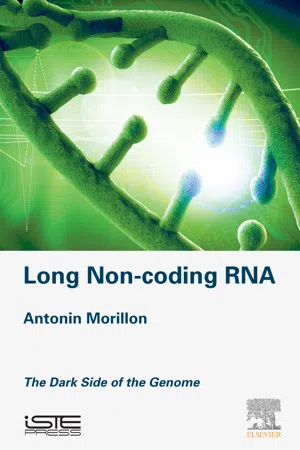
- 190 pages
- English
- ePUB (mobile friendly)
- Available on iOS & Android
About this book
The dark side of the genome represents vast domains of the genome that are not encoding for proteins – the basic bricks of cellular structure and metabolism. Up to 98% of the human genome is non-coding and produces so-called long non-coding RNA. Some of these non-coding RNA play fundamental roles in cellular identity, cell development and cancer progression. They are now widely studied in many organisms to understand their function.This book reviews this expanding field of research and present the broad functional diversities of those molecules and their putative fundamental and therapeutic roles and develops the recent history of non-coding RNA, their very much debated classification and how they raise a formidable interest for developmental and tumorigenesis biology.Using classical examples and an extensive bibliography, the book illustrates the most studied and attractive examples of these long non-coding RNA, how they interface with epigenetics, genome integrity and expression and what are the current models of their regulatory mechanisms.- This book offers a large review about the long non-coding RNA- It presents the broad functional diversities of those molecules- It presents pioneer works from the field- Provides a comprehensive review of the field- Presents fundamental and therapeutic interests
Frequently asked questions
- Essential is ideal for learners and professionals who enjoy exploring a wide range of subjects. Access the Essential Library with 800,000+ trusted titles and best-sellers across business, personal growth, and the humanities. Includes unlimited reading time and Standard Read Aloud voice.
- Complete: Perfect for advanced learners and researchers needing full, unrestricted access. Unlock 1.4M+ books across hundreds of subjects, including academic and specialized titles. The Complete Plan also includes advanced features like Premium Read Aloud and Research Assistant.
Please note we cannot support devices running on iOS 13 and Android 7 or earlier. Learn more about using the app.
Information
Non-coding RNA, Its History and Discovery Timeline
Abstract
Keywords

1.1 The biology of RNA, a century of history
1.1.1 From nuclein to the double helix
1.1.2 The “RNA world” concept

1.1.3 Small bacterial RNA: pioneers of non-coding RNA
Table of contents
- Cover
- Title page
- Table of Contents
- Copyright
- Foreword: The Modern RNA World
- Preface
- 1: Non-coding RNA, Its History and Discovery Timeline
- 2: Definition and Families of Long Non-coding RNA
- 3: Biological Functions of Long Non-coding RNA
- 4: Non-coding RNA in Development
- 5: Long Non-coding RNA and Cancer
- Concluding Perspectives
- Bibliography
- Glossary
- List of Acronyms
- Index